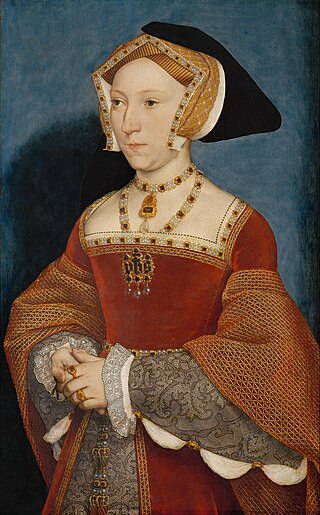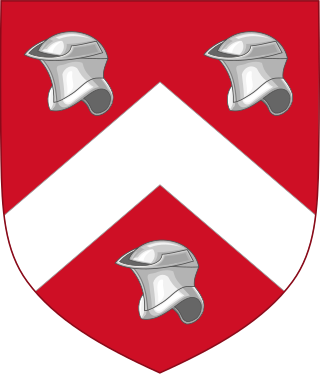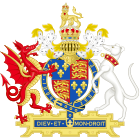
Henry VIII was King of England from 22 April 1509 until his death in 1547. Henry is best known for his six marriages, and his efforts to have his first marriage annulled. His disagreement with Pope Clement VII about such an annulment led Henry to initiate the English Reformation, separating the Church of England from papal authority. He appointed himself Supreme Head of the Church of England and dissolved convents and monasteries, for which he was excommunicated by the pope.

The House of Tudor was a dynasty of largely Welsh and English origin that held the English throne from 1485 to 1603. They descended from the Tudors of Penmynydd and Catherine of Valois. The Tudor monarchs ruled the Kingdom of England and its realms, including their ancestral Wales and the Lordship of Ireland for 118 years with five monarchs: Henry VII, Henry VIII, Edward VI, Mary I and Elizabeth I. The Tudors succeeded the House of Plantagenet as rulers of the Kingdom of England, and were succeeded by the House of Stuart. The first Tudor monarch, Henry VII of England, descended through his mother from a legitimised branch of the English royal House of Lancaster, a cadet house of the Plantagenets. The Tudor family rose to power and started the Tudor period in the wake of the Wars of the Roses (1455–1487), which left the main House of Lancaster extinct in the male line.

Anne Boleyn was Queen of England from 1533 to 1536, as the second wife of King Henry VIII. The circumstances of her marriage and of her execution by beheading for treason and other charges made her a key figure in the political and religious upheaval that marked the start of the English Reformation.

Jane Seymour was Queen of England as the third wife of King Henry VIII from their marriage on 30 May 1536 until her death the next year. She became queen following the execution of Henry's second wife, Anne Boleyn. She died of postnatal complications less than two weeks after the birth of her only child, the future King Edward VI. She was the only wife of Henry to receive a queen's funeral; and he was later buried alongside her remains in St George's Chapel, Windsor Castle.

The First Succession Act of Henry VIII's reign was passed by the Parliament of England in March 1534. The Act was formally titled the Succession to the Crown Act 1533, or the Act of Succession 1533; it is often dated as 1534, as it was passed in that calendar year. However, the legal calendar in use at that time dated the beginning of the year as March 25, and so considered the Act as being in 1533.
The Acts of Supremacy are two acts passed by the Parliament of England in the 16th century that established the English monarchs as the head of the Church of England; two similar laws were passed by the Parliament of Ireland establishing the English monarchs as the head of the Church of Ireland. The 1534 Act declared King Henry VIII and his successors as the Supreme Head of the Church, replacing the Pope. This first Act was repealed during the reign of the Catholic Queen Mary I. The 1558 Act declared Queen Elizabeth I and her successors the Supreme Governor of the Church, a title that the British monarch still holds.
Marquess of Pembroke was a title in the Peerage of England created by King Henry VIII for his future spouse Anne Boleyn.

Succession to the British throne is determined by descent, sex, legitimacy, and religion. Under common law, the Crown is inherited by a sovereign's children or by a childless sovereign's nearest collateral line. The Bill of Rights 1689 and the Act of Settlement 1701 restrict succession to the throne to the legitimate Protestant descendants of Sophia of Hanover who are in "communion with the Church of England". Spouses of Catholics were disqualified from 1689 until the law was amended in 2015. Protestant descendants of those excluded for being Roman Catholics are eligible.
The Regency Acts are Acts of the Parliament of the United Kingdom passed at various times, to provide a regent in the event of the reigning monarch being incapacitated or a minor. Prior to 1937, Regency Acts were passed only when necessary to deal with a specific situation. In 1937, the Regency Act 1937 made general provision for a regent, and established the office of Counsellor of State, a number of whom would act on the monarch's behalf when the monarch was temporarily absent from the realm or experiencing an illness that did not amount to legal incapacity. This Act, as modified by the Regency Acts of 1943 and 1953, forms the main law relating to regency in the United Kingdom today.

In common parlance, the wives of Henry VIII were the six queens consort of King Henry VIII of England between 1509 and his death in 1547. In legal terms, Henry had only three wives, because three of his marriages were annulled by the Church of England. However, he was never granted an annulment by the Pope, as he desired, for Catherine of Aragon, his first wife. Annulments declare that a true marriage never took place, unlike a divorce, in which a married couple end their union. Along with his six wives, Henry took several mistresses.

The Act Respecting the Oath to the Succession was passed by the Parliament of England in November 1534, and required all subjects to take an oath to uphold the Act of Succession passed that March. It was later given the formal short title of the Succession to the Crown Act 1534.

The English Reformation Parliament, which sat from 3 November 1529 to 14 April 1536, established the legal basis for the English Reformation, passing major pieces of legislation leading to the Break with Rome and increasing the authority of the Church of England. Under the direction of King Henry VIII of England, the Reformation Parliament was the first in English history to deal with major religious legislation, much of it orchestrated by, among others, the Boleyn family and Thomas Cromwell. This legislation transferred many aspects of English life away from the control of the Catholic church to control under The Crown. This action both set a precedent for future monarchs to utilize Parliamentary statutes affecting the Church of England; strengthened the role of the English Parliament; and provided a significant transference of wealth from the Catholic church to the English crown.

The Third Succession Act of King Henry VIII's reign, passed by the Parliament of England, returned his daughters Mary and Elizabeth to the line of the succession behind their half-brother Edward. Born in 1537, Edward was the son of Henry VIII and his third wife, Jane Seymour, and heir apparent to the throne.
British history provides several opportunities for alternative claimants to the English and later British Crown to arise, and historical scholars have on occasion traced to present times the heirs of those alternative claims.
Events from the 1530s in England.

The Regency Act 1830 was an Act of the Parliament of the United Kingdom passed to provide for the event that King William IV died while the next person in line to the throne was not yet aged 18. It provided for a regency until the new monarch reached the age of 18, and also would have enabled a posthumous child of King William IV to replace Queen Victoria on the throne. However, the Act never came into force, because William was not survived by a legitimate child and Victoria became queen at the age of 18 in 1837.
Young Royals is a series of novels for children by Carolyn Meyer based on the early lives of multiple royalties such as English and French royalty. Books in the series are mostly about the English Tudors, such as: Mary, Bloody Mary (1999); Beware, Princess Elizabeth (2001); Doomed Queen Anne (2002); and Patience, Princess Catherine (2004). The French books in the series are Duchessina (2007), about the life of Catherine de' Medici, and The Bad Queen: Rules and Instructions for Marie-Antoinette (2010). The most recent titles in the series are: The Wild Queen: The Days and Nights of Mary, Queen of Scots (2012); Victoria Rebels (2013), about Queen Victoria of the British Empire; and Anastasia and Her Sisters (2013), about the daughters of Tsar Nicholas of Russia, specifically Anastasia.

The Tudors of Penmynydd were a noble and aristocratic family, connected with the village of Penmynydd in Anglesey, North Wales, who were very influential in Welsh politics. From this family arose Owen Tudor and thereby the Welsh Tudor dynasty, that ruled England from 1485 to 1603. The Tudor dynasty ended in the early 17th century with the death of Elizabeth I.

Royal Succession bills and acts are laws or pieces of proposed legislation to determine the legal line of succession to the Monarchy of the United Kingdom.

The King's Curse is a 2014 historical novel by Philippa Gregory, part of her series The Cousins' War. A direct sequel to The White Princess, it follows the adult life of Margaret Pole, Countess of Salisbury, the daughter of George Plantagenet, 1st Duke of Clarence and Isabel Neville.












